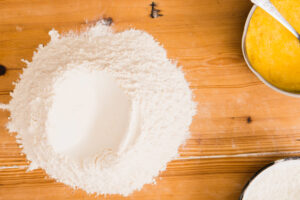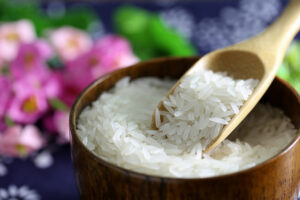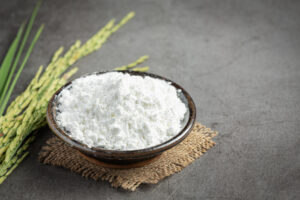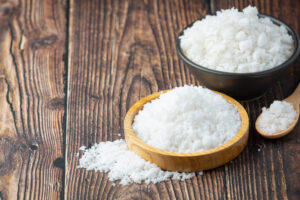Introduction:
Welcome to the Sweet Rice Flour Guide! If you’re looking to add a touch of sweetness and versatility to your culinary creations, rice flour is the perfect ingredient to explore. In this article, we will delve into the fascinating world of rice flour, uncovering its uses, benefits, and health advantages. Whether you’re a baking enthusiast or an adventurous home cook, this guide will provide you with all the information you need to make the most of this delightful ingredient.

Table of Contents
What is Sweet Rice Flour?
Let’s begin by understanding what rice flour is and how it differs from regular rice flour. Rice flour, also known as glutinous rice flour or sticky rice flour, is made from finely ground glutinous or sticky rice. Unlike regular rice flour, which is milled from long-grain or short-grain rice, rice flour has a sticky, chewy texture when cooked. It is commonly used in Asian cuisines, especially for making traditional desserts like mochi.
Nutritional Profile and Health Benefits of Sweet Rice Flour:
This flour not only adds a delectable taste and texture to your dishes but also offers several health benefits. Let’s explore its nutritional profile and the advantages it brings to your well-being.
Digestive Health Benefits:
Rice flour is known for its digestive health benefits. It contains a type of starch called amylopectin, which is easily digested by the body. This makes rice flour a gentle and soothing option for those with sensitive stomachs or gastrointestinal issues. It can help alleviate symptoms such as bloating and discomfort, providing relief and promoting better digestion.
Energy and Nutrient Boost:
When it comes to energy, rice flour is a powerhouse. It is rich in carbohydrates, which are the body’s primary source of fuel. The carbohydrates in this flour provide sustained energy, making it an excellent choice for individuals leading an active lifestyle or needing a steady supply of energy throughout the day. Additionally, rice flour contains essential vitamins and minerals like niacin, thiamin, and magnesium, contributing to your overall nutrient intake.

Gluten-Free and Allergen-Friendly:
For individuals with gluten intolerance or celiac disease, sweet flour is a fantastic gluten-free alternative. Unlike wheat-based flours, rice flour is naturally gluten-free, making it safe for those with gluten sensitivities to enjoy a wide range of delicious dishes. Additionally, sweet rice flour has a low risk of causing allergic reactions, making it a suitable option for those with various food allergies.
Sweet Rice Flour in Baking:
Now that we understand the health benefits, let’s explore how rice flour can elevate your baking endeavors. Whether you’re following a gluten-free diet or simply looking for a unique twist, rice flour can work wonders in your baked goods.
Using Sweet Rice Flour in Baking: Rice flour acts as an excellent gluten-free alternative to regular flour in baking recipes. Its sticky nature adds moisture and chewiness to the final product, creating delightful textures. Here are some tips on using rice flour in your baking adventures:
Recipes for Cakes, Cookies, and Pastries: Rice flour can be incorporated into a variety of sweet treats, including cakes, cookies, and pastries. Experiment with recipes like flour chocolate cake, chewy almond cookies with rice flour, or flaky rice flour pastries. Get creative and let the unique qualities of rice flour enhance your baked goods.

Tips for Achieving the Best Texture and Taste:
To achieve the best texture and taste when using rice flour, consider the following tips:
Combine rice flour with other gluten-free flours for better texture and structure.
Use a binding agent like xanthan gum or guar gum to improve elasticity.
Adjust the liquid content in the recipe as sweet rice flour tends to absorb more moisture.

Common Challenges and How to Overcome Them:
Working with sweet rice flour may come with some challenges, but fear not! With a few handy tips, you can overcome them:
Rice flour tends to make baked goods denser. Counteract this by adding leavening agents like baking powder or baking soda to help with rising.
Since rice flour lacks gluten, which provides structure, consider using smaller baking pans or molds to avoid a crumbly texture.
Allow your baked goods to cool completely before serving to achieve a better texture and consistency.
Sweet Rice Flour-Based Desserts and Snacks:
Rice flour opens up a world of delectable desserts and snacks. Here are some sweet treats you can create using rice flour:
Rice Flour Pancakes: Fluffy and light pancakes made with rice flour, perfect for a delightful breakfast or brunch.
Rice Flour Dumplings: Steamed dumplings with a sweet filling, often enjoyed as a dessert or snack in Asian cuisines.
Sweet Rice Flour Pudding: A creamy and comforting rice pudding made with rice flour, infused with flavors like cinnamon or vanilla.
Fusion Recipes Combining Rice Flour with Other Ingredients: Get creative in the kitchen and explore fusion recipes that blend rice flour with other ingredients from different culinary traditions. Here are a few ideas to spark your imagination:
Sweet Rice Flour Crepes with Nutella and Bananas: A delightful fusion of French and Asian cuisines, creating a mouthwatering combination of flavors and textures.
Rice Flour Pizza Crust: Swap out traditional pizza dough with a gluten-free rice flour crust for a unique and delicious twist.
Sweet Rice Flour Pancake Tacos: Combine the versatility of rice flour pancakes with the filling of your choice, such as savory meats, vegetables, or sweet fruit fillings.

Sweet Rice Flour as a Thickening Agent:
Beyond its role in baking, rice flour can be a valuable thickening agent in various recipes. Let’s explore how you can use rice flour to achieve desired textures in sauces and soups.
Using Sweet Rice Flour as a Thickener: Rice flour can replace other thickeners like wheat flour or cornstarch in your recipes. Follow these tips when using rice flour as a thickening agent:
- Create a slurry by mixing rice flour with water or other liquids before adding it to your recipe.
- Stir the slurry into your sauce or soup and cook over low heat until it thickens to the desired consistency.
- Adjust the amount of rice flour depending on how thick you want the final result to be.
Recipe and Tips for Using Sweet Rice Flour in Sauces and Soups:
Try these ideas for incorporating rice flour into your savory dishes:
Sweet Rice Flour Gravy: Create a rich and flavorful gravy using rice flour as a thickener. Perfect for accompanying roasts, mashed potatoes, or biscuits.
Creamy Rice Flour Soup: Make a velvety soup by using rice flour to thicken the broth. Add your favorite vegetables and proteins for a satisfying meal.
Sweet Rice Flour and Gluten-Free Cooking:
For individuals following a gluten-free diet, rice flour opens up a world of culinary possibilities. Let’s explore its role in gluten-free cooking and get some recipe ideas to get you started.
Exploring the Role of Sweet Rice Flour in Gluten-Free Diets: Rice flour is a staple ingredient in gluten-free cooking. Here’s why it’s a valuable addition to your gluten-free pantry:
- Gluten-Free Flour Blend: Create a gluten-free flour blend by combining sweet rice flour with other gluten-free flours like almond flour or tapioca flour. This blend can be used as a 1:1 substitute for regular flour in many recipes.
- Enhanced Texture: Rice flour adds moisture, chewiness, and a delightful texture to gluten-free baked goods, making them more enjoyable and satisfying.

Frequently Asked Questions (FAQs):
Q1. Is sweet rice flour the same as glutinous rice flour? A: Yes, Rice flour and glutinous rice flour are different names for the same ingredient. Despite the name, sweet rice flour is gluten-free.
Q2. Can rice flour be used as a 1:1 substitute for regular flour? A: Rice flour can be used as a substitute for regular flour in some recipes, but it may require additional ingredients or adjustments to achieve the desired results. Experimentation is key to finding the right balance.
Q3. How do I store rice flour for maximum freshness? A: To keep rice flour fresh, store it in an airtight container in a cool, dry place away from direct sunlight. Using it within six months is recommended for optimal quality.
Q4. Does rice flour have any potential allergens? A: Rice flour is generally considered safe for individuals with common allergies, including wheat and gluten. However, always check the packaging and consult with a medical professional if you have specific concerns or known allergies.
Q5. Is rice flour suitable for diabetic individuals? A: Rice flour is high in carbohydrates and can affect blood sugar levels. Diabetic individuals should monitor their intake and consult with a healthcare professional to determine its suitability in their diet.
Conclusion:
In conclusion, sweet rice flour is a versatile and delightful ingredient that adds a touch of sweetness and unique qualities to your culinary creations. With its gluten-free nature, health benefits, and wide range of uses, rice flour opens up a world of possibilities for both baking enthusiasts and home cooks. Whether you’re exploring traditional Asian cuisine or experimenting with fusion recipes, rice flour is sure to elevate your dishes to new heights. Embrace the sweetness, embrace the versatility, and embrace the world of rice flour in your kitchen.
